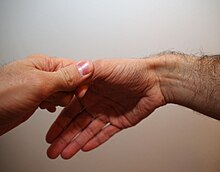Finkelstein test
The Finkelstein test (after Harry Finkelstein , American surgeon, 1865-1939) is a clinical test in orthopedics that is considered pathognomonic (characteristic of disease) for tendovaginitis stenosans de Quervain ( Quervain disease ), a chronic inflammation of the first tendon compartment of the hand , applies. The test is also positive for Wartenberg syndrome , a nerve compression syndrome of a terminal branch of the radial nerve .
The implementation was described in the original work by Finkelstein (1930) as follows:
- “On grasping the patient's thumb and quickly abducting the hand ulnarward, the pain over the styloid tip is excruciating. This is probably the most pathognomonic objective sign. "
- ("When the patient's thumb is grasped and a rapid ulnar abduction is performed by hand, the pain over the radial styloid process is excruciating. This is possibly the most pathognomonic objective sign [of Quervain's disease].")
In another version, which has become widely accepted in the literature today, the thumb is hammered into the fingers and the hand is then passively spread in the joint towards the ulna. However, performing the test in this way produces false positive results in the diagnosis of Quervain's disease . It originally goes back to a publication by Eichhoff (1927). The mix-up occurred in a work by Leão. (1958), on which other authors later orientated themselves.
In view of this fact, the test commonly used today (with the thumb crossed in) is sometimes correctly referred to as the Eichhoff test and the version with the free thumb as the actual Finkelstein test .
Individual evidence
- ↑ a b c B. G. Elliott: Finkelstein's test: a descriptive error that can produce a false positive. In: J Hand Surg [Br]. 17 (4), Aug 1992, pp. 481-482. PMID 1402284
- ↑ Hans Assmus, Gregor Antoniadis (Ed.): Nervenkompressionssyndrome . 3. Edition. Springer-Verlag, Heidelberg, ISBN 978-3-642-55212-0 , p. 133 ( springermedizin.de [accessed July 3, 2019]).
- ↑ H. Finkelstein: Steno Sing tendovaginitis at the radial styloid process. In: The Journal of Bone & Joint Surgery . 1930, 12, pp. 509-540.
- ↑ E. Eichhoff: On the pathogenesis of tenovaginitis stenosans. In: Bruns' Contributions to Clinical Surgery. CXXXIX, 1927, pp. 746-755.
- ↑ L. Leão: De Quervain's disease. A clinical and anatomical study. In: Journal of Bone and Joint Surgery. 40A, 5, 1958, pp. 1063-1070.
Web links
- Finkelstein's test at www.whonamedit.com

